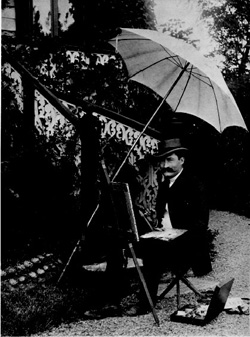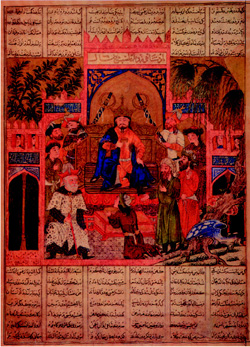IRANICA: PRESERVATION: ESSAY
Book arts of the Islamic world had begun to enter European collections by the seventeenth century. It was at this time that the Bodleian Library acquired its first Persian manuscripts.1 Rembradnt van Rijn (1606-1669), made drawings inspired by Mughal miniatures brought back to the Netherlands by merchants of the Dutch East India Company. Persian, Indian, and Turkish codices and manuscript paintings, however, did not enter European or North American collections in any great number until the nineteenth century. Museums acquired large quantities of these materials during the 1880s. Sidney Churchill (1862-1921), keeper of the Department of Oriental Manuscripts at the British Museum from 1884-1894, sent from Iran to London (via Istanbul) 240 manuscripts, some of which originally came from the libraries of Qajar nobility.2 In the same decade, South Kensington Museum curator Caspar Purdon Clarke (1846-1911) enriched that museum’s store of Mughal painting through purchases made in India.3 Several collectors even ventured to areas of Central Asia that had been visited infrequently by Western travelers: French jeweler Henri Vever (1854-1942) and the Swedish scholar/art dealer Frederik R. Martin (1868-1933) both traveled to Bukhara (in present-day Uzbekistan) in the 1890s, hoping to uncover artworks at lower prices than could be found in the more seasoned art markets of Iran and India.4
Several factors contributed to this surge in the volume of illustrated Islamic manuscripts circulating among institutions and individuals in Europe and North America. To begin, changes in the political landscape during the second half of the nineteenth century opened up opportunities for the transport of books, painted folios, and other art objects from the Middle East and South Asia to Europe. The sacking of Delhi by Nadir Shah (1688-1747) in 1739 had resulted in the exodus of many Mughal manuscripts from India to palaces in Iran and, from there, to European and North American collections; the Sepoy Rebellion of 1857, however, made the royal libraries of the Mughal court once again vulnerable to looting, this time by British forces. Meanwhile, Russian military expansion into Central Asia in the second half of the nineteenth century opened up that region to Western collectors and scholars.5

Henri Vever, French jeweler and collector of Islamic art, ca. 1895.
The opening of the Suez Canal in 1869, moreover, facilitated the shipment of Persian and Mughal art from points east to Europe, while advances in rail transport facilitated the exchange of goods, including manuscripts, along routes circuiting Europe, North Africa, and Asia. International trade was further aided by multilingual, cosmopolitan art dealers, many of them Armenians born in Ottoman Turkey, who had connections in both Europe and the Middle East.
Islamic manuscripts appealed to individual collectors and institutions for a variety of reasons. During the earlier part of the nineteenth century, an awareness of and appreciation for Arabic and Persian books was limited largely to a small community of bibliophiles who had a rarefied interest in the history of paleography.6 However, as Europeans and North Americans became more familiar with Islamic book arts later in that century, the manuscript image came to be considered of primary importance, whereas the accompanying text was often discounted or even excised from the folio. Indeed, when a heavily illustrated sixteenth-century copy of the Akbarnama, the memoirs of the Mughal emperor Akbar (1542-1605), were purchased by the South Kensington Museum in 1895, the paintings were removed from the book and numbered in the manner of a European codex (i.e. from left to right). The text, meanwhile, was stored separately and forgotten until its rediscovery in 1905 by historian Henry Beveridge (1837-1929). This piecemeal approach to the Islamic book remained standard practice well into the twentieth century, though several notable exhibitions in the early decades after the turn of the century demonstrated scholarly interest in aspects of book production that extended beyond illustrated folios.7
Despite the surge in the volume of Persian, Turkish, and Indian manuscripts traveling westward during the latter half of the nineteenth century, book arts were still considered by many to be of lesser importance than Islamic ceramics and metalwork, which appealed more to the then-popular European taste for ‘industrial’ arts.8 The end of the nineteenth century, however, signaled a re-evaluation of manuscripts and other ‘decorative’ arts, in particular as the art nouveau movement gained momentum. It is understandable, then, that two early collectors of Persian and Mughal manuscript paintings—Henri Vever and Louis J. Cartier (1875-1942)—were jewelers. As each had an acute appreciation for craftsmanship, as well as an affinity for dynamic designs, Islamic paintings could appeal to them on a level that transcended textual and narrative details.9
This new esteem for Islamic manuscripts and other deluxe objects was evidenced in the 1912 Exhibition of Persian Art at the Musée des Arts Décoratifs in Paris—the first exhibition to focus exclusively on the arts of the book.10 Henri Vever and Georges Marteau, the organizers of the show, included selections from important Parisian collections—including their own—in the exhibition. The commemorative volume that Vever and Marteau published in 1913, which includes numerous color and black and white plates and a detailed study of scribal signatures, is a testimony to the authors’ enthusiasm for the material they and others had collected.11 Though the exhibited paintings were reproduced in this publication as isolated images devoid of context, the accompanying essays nevertheless marked a great advance in the consideration of the Islamic book as an entity comprising multiple components. While primacy was given to the painted miniature and the individual artist, Vever and Marteau also examined bindings, calligraphy, colophons, paper, and illumination.

Shah Zav enthroned, page from the Great Mongol Shahnameh of the 1330s, formerly in the collection of Henri Vever.
This reappraisal of Islamic book arts did not save manuscripts from damage at the hands of dealers who were eager to maximize their profits. The fourteenth-century Great Mongol Shahnameh (‘Book of Kings’) remains one of the most famous instances of such destruction. When this rare Persian royal manuscript failed to elicit a satisfactory offer from a buyer, the Parisian dealer Georges Demotte (1877-1923) dismembered the codex and sold off the paintings to multiple collectors. In some cases, where both the recto and the verso of a single folio featured illustrations, Demotte split the page and mounted each painting onto a new, fabricated ‘folio’, which he constructed by pasting unrelated segments of text to the compositions’ reverses. This process enabled Demotte to profit from the sale of two separate paintings, and simultaneously resulted in the irreparable mutilation of an early Persian masterpiece.12 Today, Demotte’s actions seem objectionable, but his crafty practices were considered acceptable in his own time. Treated as isolated, autonomous entities, manuscript paintings were collected for their formal qualities, rather than for their codicological or historical aspects.
In the years following the First World War, another wave of Islamic manuscripts and illustrated folios flooded European and North American art markets. This was a result of the chaos surrounding the collapse of the Qajar and Ottoman dynasties, which created ideal conditions for the removal of art objects from royal palaces and libraries.13 The seminal 1931 Exhibition of Persian Art at Burlington House, London, organized by Arthur Upham Pope, sparked further interest in Islamic book arts. The Burlington exhibition inspired a new generation of scholars who would take a deeper interest in the socio-historical context and iconographical significance of manuscript illustrations.14 In the ensuing years, however, the dictates of the market would continue to affect scholarship. When Baron Maurice de Rothschild died in 1957, a manuscript in his collection, the early sixteenth-century Shah Tahmasp Shahnameh, came onto the market. Soon after Arthur A. Houghton, Jr., purchased this book, considered to be one of the greatest works of art produced during the Safavid dynasty (ca. 1501-1722), scholars Stuart Cary Welch and Martin B. Dickson began an in-depth study of its images and text.15 Fortunately, a facsimile was produced, for Houghton, Jr., eventually sold his Shahnameh—folio by folio. Today this once monumental codex is divided among a number of museum and private collections.
Many Islamic books, however, were spared this fate. Some manuscripts’ illustrations, because of their small size, were less marketable as single composition works. Other manuscripts, because their paintings did not exhibit the formal qualities of classical, royal Persian painting of the early sixteenth century, which was prized by most collectors above all else, were incidentally left intact; while some manuscripts remained complete because they did not feature the complex narrative compositions that were most popular among art dealers’ clientele. A number of illustrated manuscripts, which Muslim collectors had long treasured and conserved, were subsequently preserved in Western collections, in part because their contents did not lend themselves to sale by individual folio, but also because such works found favor among collectors whose tastes lay outside the prescribed niches of the art market.
YR